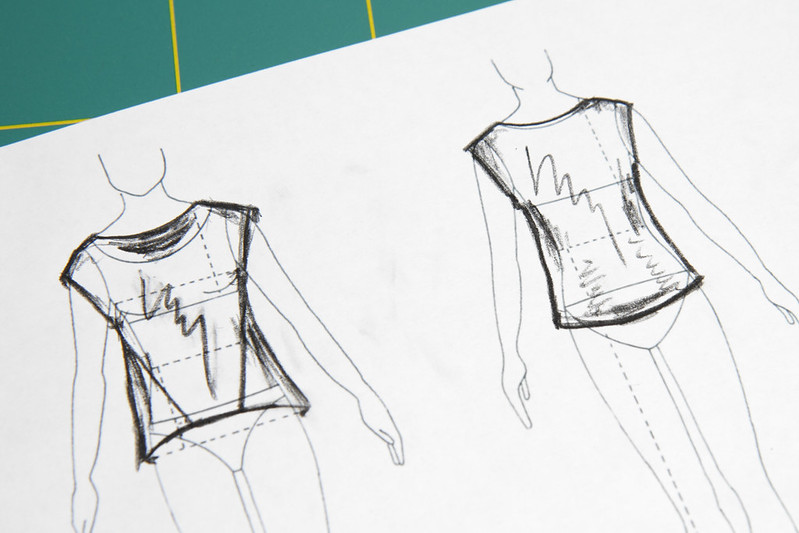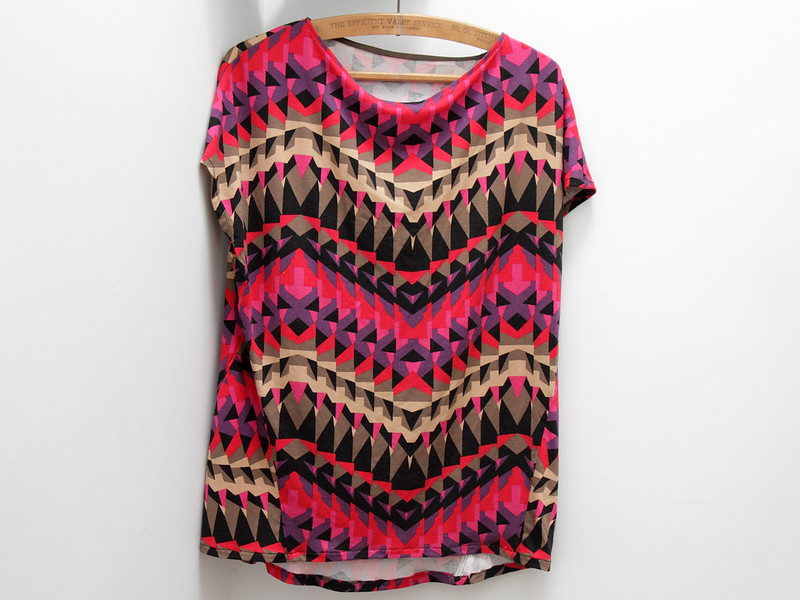On a high after the success of my last sewing project, I thought I’d try something more ambitious while being small enough to be achievable in my very limited sewing time.
This top is a favourite from my wardrobe. I love everything about it – the shape, the bold print, the colour – but it’s looking a little faded now (or well-loved, as I prefer to think of it) and I would be sad to retire it without a suitable replacement.
Despite being a simple shape, the top has a number of interesting design details that I wanted to keep; a draped neck at the front, dipped hem at the back and unusual triangular side panels the face forwards.
Many moons ago when I took a pattern cutting course at London College of Fashion, the tutor described a technique called “rubbing off” (sounds rude, isn’t) for making pattern pieces from an existing garment without taking it apart. This garment seemed like a suitable candidate, being of a simple shape, with no darts, and being designed for stretch fabric that is relatively forgiving. I followed this tutorial and jumped straight in with my dot-and-cross (conventionally one would use a flexible material like muslin, but I didn’t have any).
One of the aims of my summer sewing plan is to use materials that are already in my stash, and luckily I had the perfect fabric – a geometric print viscose jersey from Montreux Fabrics. I bought this at in 2015 thinking it would make a great dress, but never found the right project.
At the time of buying, I didn’t know the fibre composition, and I didn’t even know what viscose was, but having recently started researching sustainable textiles I now know that viscose is a pretty good eco-fibre as it is biodegradable and often made from waste products, like wood pulp and cotton fibres that are too short to be spun. It is a cellulose fibre that’s described as ‘semi-synthetic’ because of its complex manufacturing process. It feels silkier than cotton jersey and has a nice weight to it and drape. Unlike true synthetics, viscose does not cause horrible microfibre pollution because shedded fibres are biodegradable. Needless to say I was very happy to discover that this piece was viscose, but even if it weren’t, the most sustainable source of materials is always using what one already owns.
Did I mention that, in addition to never having done a rub off, I zero experience with stretch fabrics? What could possibly go wrong?
The rubbing off part was straightforward enough (but would have been easier with muslin). After getting the shape of the pattern pieces from the garment, I re-checked key measurements against the garment and made sure the pieces matched. This was surprisingly difficult, especially getting the neckline and armholes right.
I added seam allowance using a Patternmaster (oh, how I love that thing!). I added a notches on the shoulder and side panel seams to help me match up the pieces because stretch fabrics can, well, stretch. I lengthened the pattern by about 2cm but made no other adjustments to the pattern.
When cutting the fabric I made very, very sure to line up the pattern exactly with the centre of the garment, pinning the folded fabric in several places so get both sides lined up. With such a strong motif, alignment is make-or-break. I decided to cut the side panels off grainline as a design feature.
Having stitched the shoulders I discovered that the neckline was still wrong (too high at the front), but this was easy to fix simply cutting a bit off and I had no other issues with my pattern.
I tried to copy the same sewing and finishing techniques as on the original garment. In some cases this worked well – bias tape for the neck, and top-stitching on the side panels. In other cases this was disastrous – my machine seems to be incompatible with a 4mm twin needle, and I had to dismantle the machine’s underbelly to de-jam and retrieve the tip.
https://www.instagram.com/p/BkCz-d6H4Io/
I had more luck with a 2.5mm twin needle but I am not over the moon with the results as I found it very difficult to manage the tension, though it looks neat from the right side. I couldn’t zigzag the stretchy edges without a horrible mess, so I did concealed seams for the shoulders and sides, which worked great but led to bulky underarms where the three pieces meet. Again, it looks OK from the outside, so I’m happy.
To my surprise I had no problems with stretching on the actual seams. The end result is great and I’m definitely going to sew with more knit fabrics in future.
I obviously didn’t do a perfect job of copying the pattern pieces because the fit in not quite the same as the original, but I like it even more! It has already had a lot of compliments.
Having bought the fabric with a dress in mind I have a lot left over, so I’m going to attempt some toddler leggings/joggers with ribbed cuffs. Which leads me on to a little aside…
I can see why overlockers are a wonderful thing, I really do hate messy edges. After this experience with stretch fabric I would love an overlocker, but I can’t justify such a big purchase. I am considering a new sewing machine though. I have a low-mid range Elna, which struggles with anything other than straight stitch on medium-weight cotton. It needs constant servicing even though I am nice to it (honest). I actually only have it because the Brother I bought had a fault, and the vendor didn’t have another in stock so offered me the Elna, which with hindsight was a poor trade! With a better machine, maybe I wouldn’t need an overlocker?
Do you have a sewing machine that you love? Please tell me!
I don’t quilt or embroider, I use buttonholes and basic stitches only. I am looking for a real workhorse – smooth and reliable that will stay with me through thick and thin (fabrics). I am open to an industrial machine but I don’t know the first thing about them. All recommendations appreciated!




